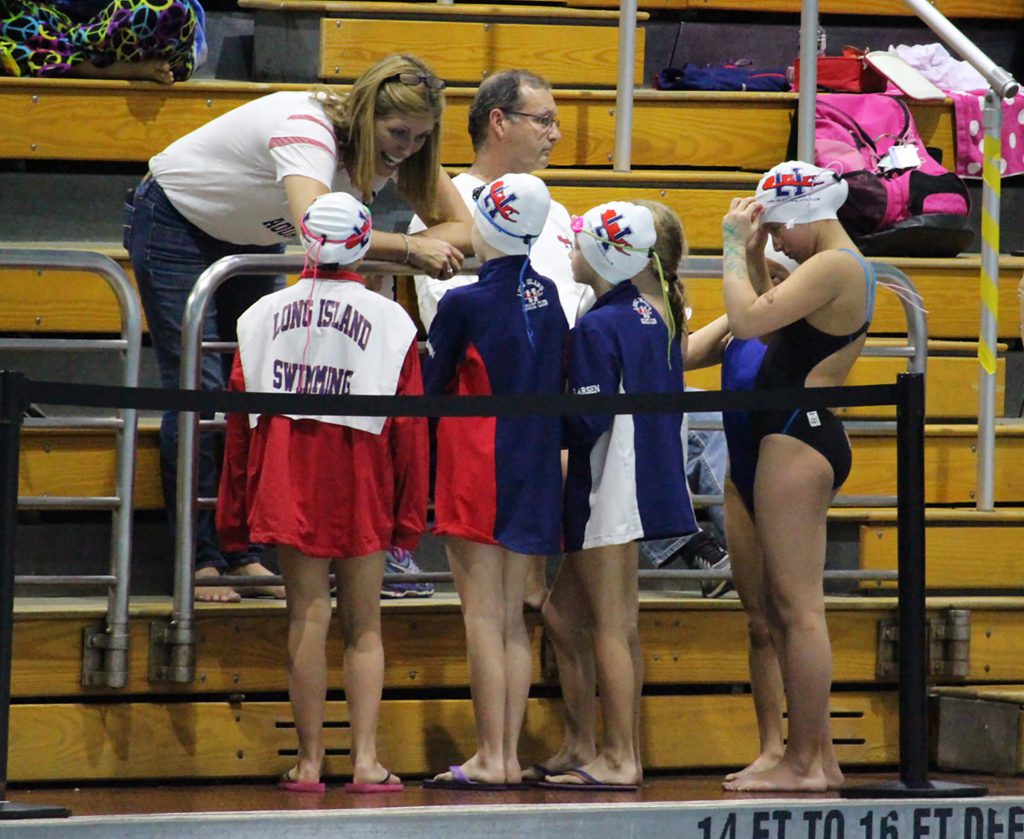An Outsider’s View of Swimming at the CeraVe Invite

By Brad Klein, Swimming World Intern.
There are various traditions I associate with attending a sporting event as a fan. Heckling at the referee, accumulating peanut shells at the ballpark and the hoots and hollers of the student sections are all to be expected at a major sport competition.
Much different are the hoots and hollers that echo throughout the humid, chlorine-filled aquatic center from teammates and from parents who are just as dedicated to the time-consuming sport that is swimming. As I first stepped into the large pool area at Rutgers for the Sunday morning session at the CeraVe Invite, an overwhelming heat wave smacked my face, making me want to turn back towards the air-conditioned car, despite the low temperature and snow on the ground in central New Jersey.
If it weren’t for the humidity, you may confuse a swim meet with a seven-year-old’s birthday party, where children compete to see who can make the loudest sound. Except here, it is the adult coaches who hoot and holler at their swimmers.
After several hours of listening to this cheering, I developed a theory that they have a communication system developed from practice. Maybe “HOOT!” means go faster, and “HA” means you have the lead? Can the swimmers actually hear their coaches through the water, and do they actually respond to that instruction? Tough to tell.
In land sports that I am used to, different stances and strategies are used. However, in swimming, there are different strokes, and each competition is categorized by stroke. Why do they do that? Isn’t the goal to go fast? Why do swimmers swim butterfly if freestyle is faster?
In basketball, the goal is to have more points than the other team at the end of the game. But the games aren’t categorized by how many points each shot is worth. By that logic, backstroke seems meaningless. In my eyes, it is the equivalent of a soccer game in which the players are only able to use their left feet. Why must the sport make the competition unnecessarily difficult on the swimmers, as if they have one hand tied behind their backs?
Despite my lack of understanding for the sport, I can of course appreciate the physical difficulty of swimming. A good swimmer is obviously in tip top shape. Speed, strength and endurance are all keys to becoming a champion swimmer. But don’t swimmers get bored during a two-hour practice or a long-distance race like the 1500?
Unlike in most other sports, there’s no way to play defense in swimming. Did some of these kids chose to swim because playing defense in other sports was boring? Defense is just as important as offense in any sport that involves a ball, but in swimming it’s physically not possible—unless a swimmer decided to tug on opponent’s ankle during the race.
At the end of the day, swimming just does not make sense to me. But that’s to be expected since I never swam competitively. But with that said, I do respect the time and energy swimmers and swim coaches put in to achieve greatness. Plus, swimmers have the advantage of always being in shape for beach season.
All commentaries are the opinion of the author and do not necessarily reflect the views of Swimming World Magazine nor its staff.





Wow. I hope in your stint as an intern you learn to appreciate this sport more than is indicated in the article. I recommend if you are able to swim at all, attend a competitive practice and try to keep up. As a long-time swim parent, your take on the sport leaves room for growth.
Agreed mallees mom!
I’m trying figure out how you can be an intern at a magazine that is all about Swimming when you clearly have no idea! Yes, the title states an Outsiders Vier but shouldn’t you have an idea about competitive swimming to right about it?
As a Swim parent that never took any swim lessons and especially never swam competitively (I can swim to save myself), I educated myself to all aspects in the world of competitive swimming. So much so that now I’m a USA Swimming Official. Every stroke requires a specific technique to effectively execute–if you do the stroke wrong then you’re going to get DQ’d (that means disqualified). Every distance is executed differently–you’re sure as heck not going to go full out in the 1500 like you would in the 50!
Now that you’ve experienced a swim meet, take a step back and go to a practice—you’ll be even more perplexed. You’ll also respect these athletes a heck of a lot more as they bust their butts morning and nights 5-6 days/week!
I’m thankful that I’ve experienced a variety of sports both as a player and spectator as it prevents me from having a narrow minded view on what competition entails.
The CeraVe invitational is a partnership with local high schools and the Berkeley Aquatic club to teach young students media skills such as announcing, videography, photography and sports journalism.
Over the years, a number of these interns have gone on to graduate from college with journalism degrees. We are proud to give all of them an opportunity to develop their skills including feedback from the public.
Yes, Swimming World puts its name out there when it associates with the final content. But in the end, the ability to encourage journalism in the United States far outweighs any negative impact.
Mr. Rut miller has the right ide. It is clear that swimming is a competitive. Sport and taken very seriously by parents and swimmers .that said this was a terrific well written and amusing article written by a columnist. Who is an intern.I will bet my bottom dollar that someday the author ois going to be a famous columnist or sportscaster